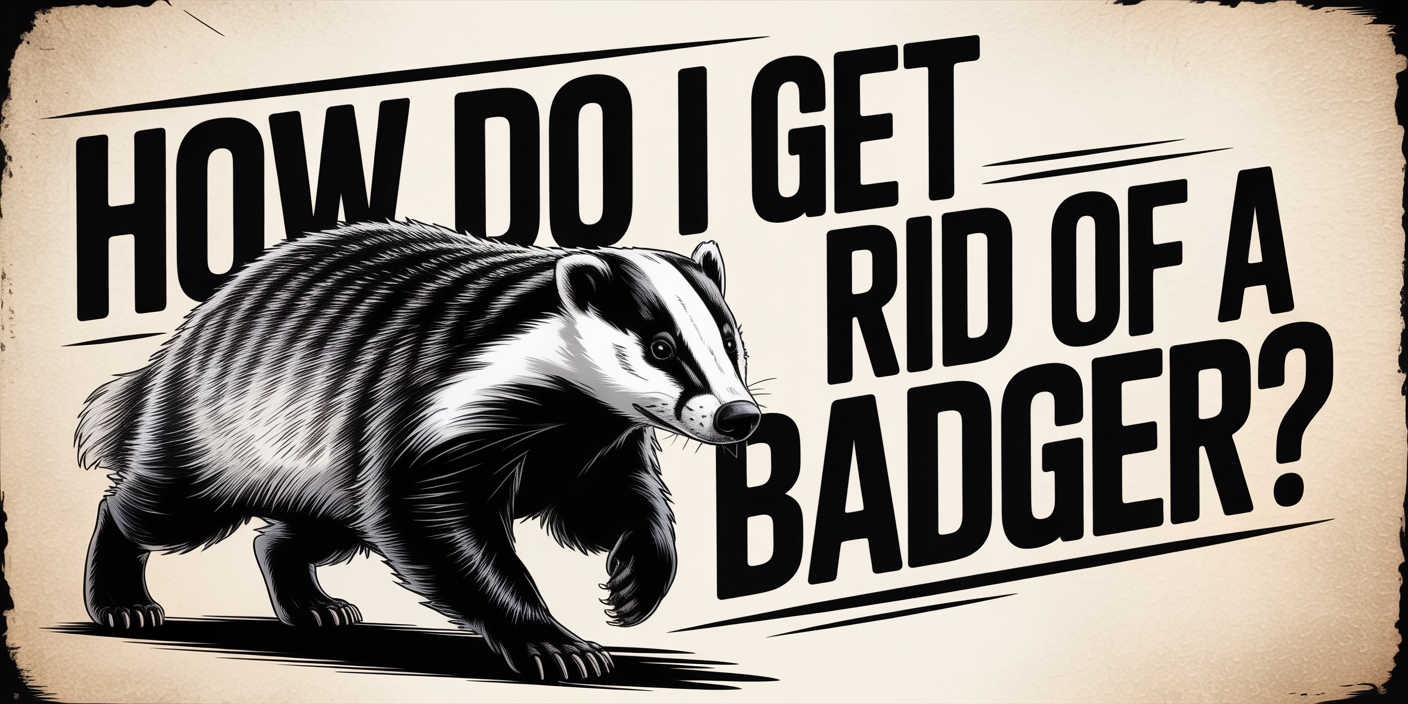To get rid of a badger, start by securing your property with deep fencing to prevent burrowing and remove food sources like fallen fruit and trash. Use humane traps or deterrents like predator urine, but be mindful of local wildlife laws. If these methods don’t work, contact a professional wildlife removal service like AAAC Wildlife Removal for safe and legal removal.
Badgers might seem like an adorable part of nature, but when they show up in your yard or garden, they quickly turn into a serious problem. Known for their burrowing and digging habits, badgers can wreak havoc on lawns, flower beds, and even structural foundations. If you’re dealing with a badger, you know the damage isn’t just cosmetic, it’s downright frustrating.
You’ve probably tried a few DIY methods or perhaps even tossed out some “badger repellent” hoping they’d just go away. But the truth is, getting rid of a badger is rarely a one-off job. Without a proper plan, these persistent critters will return, digging deeper into your home’s foundation or garden. That’s where the expertise of AAAC Wildlife Removal comes in. We don’t just remove the badger, we tackle the root cause and provide a long-term solution to keep them from coming back.
In this guide, we’ll walk you through why badgers are such a nuisance, the reasons DIY methods fail, and the safest, most effective way to handle a badger problem. Let’s dive in!
H2: Understanding Badgers: The Secretive, Destructive Intruders in Your Yard
Badgers may seem like cute creatures from a distance, but when they invade your property, they can quickly transform from charming wildlife to a major headache. These nocturnal animals are excellent diggers, and their burrowing habits can cause serious damage to your lawn, garden, and even your home’s foundation if left unchecked.
A badger’s most noticeable trait is its powerful digging ability; they dig large, complex burrows called setts, which can disrupt your landscaping, destroy plant roots, and create dangerous holes that are hard to repair. Their relentless foraging for food can also cause significant damage to vegetable gardens and grass lawns, especially in the spring and fall when they’re actively preparing for colder months.
While badgers are typically shy and elusive, they can become persistent when food sources are abundant, and if they’ve found a spot on your property that suits their burrowing needs, you’ll likely find them sticking around. This is why understanding badgers and their behavior is crucial in determining the most effective approach to manage a badger problem before it escalates.
H2: Spotting Badger Activity: Signs They’re Turning Your Garden Into Their Playground
When a badger moves into your garden, it doesn’t always announce its arrival with a big sign. However, there are a few clear signs that can tip you off that these nocturnal invaders have made themselves at home on your property. Recognizing these signs early on can help you address the issue before it causes extensive damage.
Here’s what to look for:
- Burrows and Digging: The most obvious sign of badger activity is burrowing. Badgers dig large, deep tunnels to create their sets. If you notice mounds of dirt or holes in your lawn, particularly near fences, bushes, or under garden sheds, you may have a badger problem.
- Damaged Garden: Badgers are also known to destroy gardens while searching for food. If you find your plants uprooted or roots disturbed, it could be a sign that a badger is foraging in your vegetable patch or flower beds. They typically dig to find earthworms, insects, or bulbs.
- Tracks and Trails: Badgers leave distinctive tracks, about 3 to 4 inches wide, with five toes and claws visible in the dirt. If you see these prints near the burrows or other damage, it’s another indicator that badgers are the culprits.
- Noises at Night: If you hear scratching or digging noises coming from beneath your home, shed, or near a wooded area during the night, it could be a badger. These nocturnal creatures are most active after dusk, so keep an ear out.
- Scent: Badgers are also known to leave behind a musky scent around their burrows. If you notice a strong, unpleasant odor near the area where you’ve seen damage, it’s a strong indication that badgers have been frequenting your garden.
These signs, though subtle, can quickly snowball into bigger problems if left unchecked. Badger damage is not just a cosmetic issue, it can affect the structural integrity of your garden and home. Identifying these signs early is critical for deciding whether to go the DIY route or seek professional help before things escalate.
H2: Effective Ways to Deter Badgers and Keep Them Out of Your Garden
Once badgers have started to frequent your property, it’s essential to act quickly to prevent further damage. While it might seem tempting to take matters into your own hands, effective badger deterrence requires more than just waving a broom or hoping they’ll go away. Below are a few proven methods you can use to deter badgers and keep them from coming back.
H3: Secure Your Garden with Fencing
One of the most reliable ways to keep badgers out is to install strong, tall fencing around the areas they’re targeting. The key is ensuring the fence is deep enough into the ground to prevent them from burrowing underneath. Use a fence that’s at least 3 feet tall and dig it 6-8 inches deep into the soil. You can also bend the bottom of the fence outward at a 45-degree angle to make it harder for badgers to dig beneath it.
H3: Eliminate Food Sources
Badgers are primarily attracted by easy food sources. If you’re dealing with a badger problem, consider removing things that might attract them. Clean up fallen fruit from trees or garden plants. Secure trash bins and compost piles with tight-fitting lids. Avoid leaving pet food or birdseed out overnight. By cutting off their access to food, you reduce the chances of badgers sticking around.
H3: Use Scent Deterrents
Badgers rely heavily on their sense of smell to navigate and identify potential food sources. You can use scent-based deterrents to make your property less appealing. Soak rags in ammonia and place them near burrow entrances. Some homeowners use fox or coyote urine (available at garden stores) to create the illusion of a predator presence. Badgers will avoid areas where they sense a threat. You can also make your plants less inviting by spraying them with a mixture of garlic, hot pepper, and water. Badgers dislike strong scents and spicy flavors.
H3: Close Off Burrows and Set Traps
If badgers have already dug burrows on your property, it’s essential to close off those entry points. First, make sure the badger isn’t inside, as it’s illegal to trap or relocate an animal while it’s within its burrow. Once you’re sure it’s empty, fill in the holes and cover them with mesh wire or heavy rocks to prevent re-entry. If the badger is still active in the area, consider setting humane traps to capture and relocate it safely.
H3: Call the Professionals
While there are several DIY deterrents you can try, sometimes the problem requires professional intervention. AAAC Wildlife Removal specializes in badger control, providing humane trapping, removal, and exclusion services to ensure they don’t return. We’ll help with everything from initial assessments to sealing potential entry points, giving you peace of mind that your property is protected.
H2: The Positive Role Badgers Play in the Ecosystem
While badgers are often seen as pests when they invade gardens and yards, they play an important role in the ecosystem. These nocturnal creatures, as natural foragers and diggers, contribute significantly to the environment. Badgers help with soil aeration, which improves the quality of the soil by allowing air to reach deeper layers, benefiting plant health and root systems. Their burrowing also provides a unique form of natural pest control, as badgers feed on earthworms, insects, and small rodents, keeping populations in check. This is particularly beneficial in maintaining healthy plants and preventing harmful pests from overpopulating.
In addition to soil health, badgers contribute to biodiversity by providing shelter for other species. Their burrows, or setts, are often used by smaller animals like rabbits, foxes, and even birds. This shared habitat supports a more diverse ecosystem, enhancing the overall balance of local wildlife. Furthermore, badgers assist with nutrient recycling in the environment. By feeding on various prey, they help cycle nutrients back into the soil, enriching it with organic matter and promoting plant growth. While they may cause disruptions when they invade gardens or homes, badgers undeniably have a valuable ecological function when left undisturbed in their natural habitats.
H2: DIY vs. Professional Badger Removal: Why Hiring a Pro Is the Best Choice
While DIY methods for badger removal, like using repellents or setting traps, may seem cost-effective, they often provide only temporary relief and come with significant risks. Badgers are strong, protective animals, and attempting to handle them yourself can lead to dangerous encounters. Furthermore, many DIY methods overlook important wildlife protection laws, which can result in fines or legal trouble.
Hiring a professional service like AAAC Wildlife Removal ensures that the job is done safely, legally, and effectively. Our experts not only use humane and legal methods to remove badgers, but we also offer comprehensive follow-up services to prevent future infestations. When it comes to dealing with badgers, entrusting the task to professionals saves you time, money, and the hassle of potential risks down the road.




